Earthquake Evacuation Choice and Management in a Developing Archipelagic Country—A Case Study of Surigao City, Philippines
Abstract
1. Introduction
| Date | Location | Magnitude | Deaths | Affected Houses | Destroyed Houses (Units) | Estimated Damage (PhP) |
|---|---|---|---|---|---|---|
| 10 Feb 2017 1 | Surigao City | 6.7 | 8 | 10,645 | 565 | 720 million |
| 15 Oct 2013 2 | Bohol | 7.2 | 222 | 79,217 | 65,815 | 2.5 billion |
| 6 Feb 2012 3 | Negros Oriental | 6.9 | 51 | 15,787 | - | 383 million |
| 15 Nov 1994 3 | Mindoro | 7.1 | 78 | - | 7566 | - |
| 16 Jul 1990 3 | Northern & Central Luzon | 7.8 | 2412 | - | - | 10 billion |
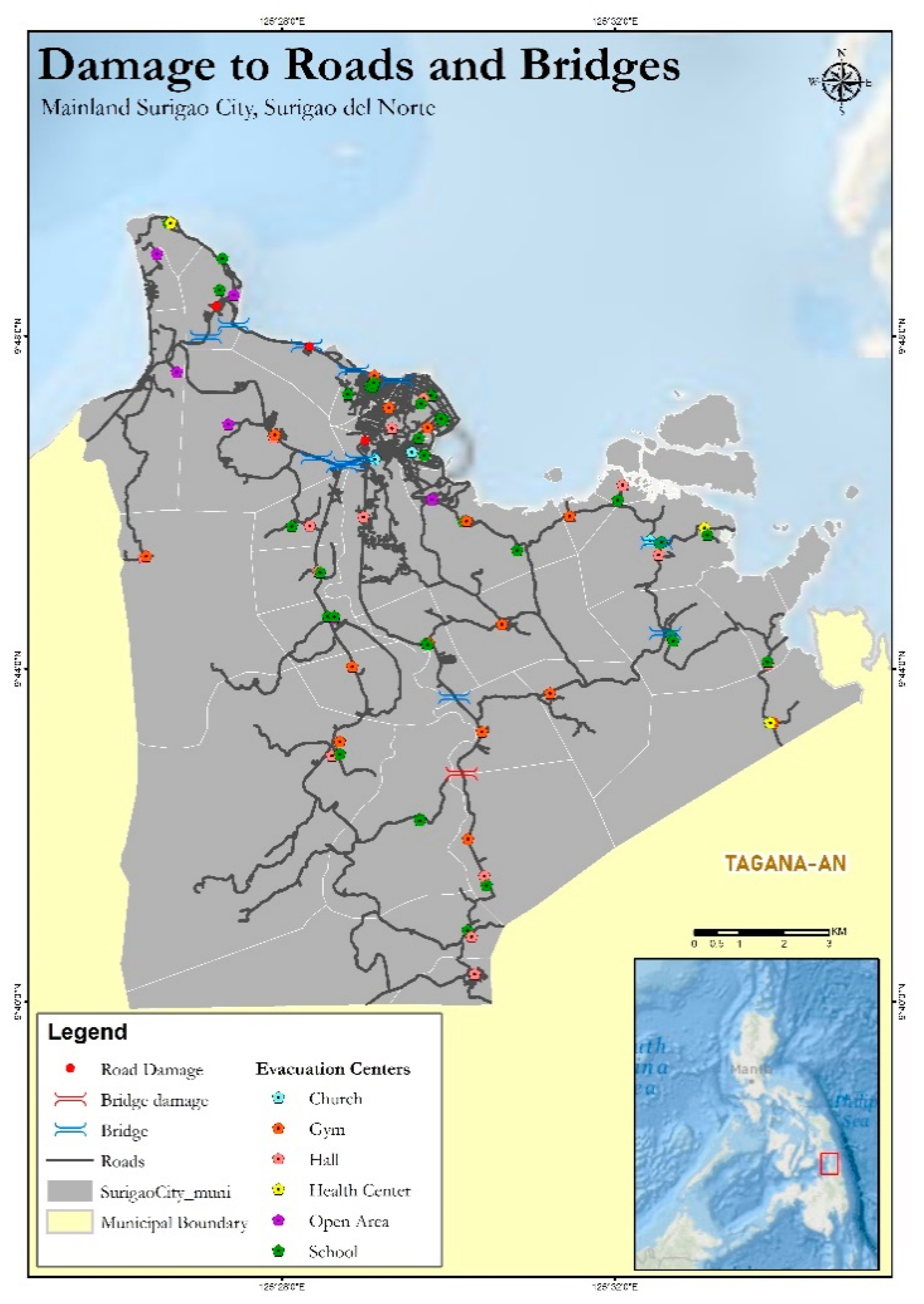
| Type of Facility | No. of Facilities | Percentage, % |
|---|---|---|
| School | 35 | 43% |
| Gymnasium/Covered Court | 21 | 26% |
| Barangay Hall | 14 | 17% |
| Church | 4 | 5% |
| Health Center | 3 | 4% |
| Open Area | 4 | 5% |
| TOTAL | 81 | 100% |
2. Methodology
2.1. Study Area and Data Source
2.2. Descriptive Statistics
2.3. Nested Logit Model
3. Results and Discussion
3.1. Earthquake Evacuation and Duration Choice
3.2. Earthquake Evacuation and Travel Mode Choice
4. Earthquake Disaster Management and Planning
5. Summary of Findings and Recommendations
Author Contributions
Funding
Acknowledgments
Conflicts of Interest
References
- UNDRR. Disaster Risk Reduction in the Philippines. 2019. Available online: https://www.unisdr.org/files/68265_682308philippinesdrmstatusreport.pdf (accessed on 10 March 2021).
- World Bank. GDP Growth (Annual %). 2019. Available online: https://data.worldbank.org/indicator/NY.GDP.MKTP.KD.ZG?end=2018&locations=PH&start=2015 (accessed on 20 May 2021).
- GFDRR. GFDRR: Philippines. 2017. Available online: https://www.gfdrr.org/sites/default/files/publication/GFDRR%202017%20Annual%20Report_0.pdf (accessed on 20 May 2021).
- Silent Gardens. Philippines Earthquakes 2019. 2019. Available online: https://www.silent-gardens.com/earthquakes.php (accessed on 15 March 2019).
- Pailoplee, S.; Boonchaluay, N. Earthquake Activities in the Philippines Islands and the Adjacent Areas. Geosci. J. 2016, 20, 877–889. [Google Scholar] [CrossRef]
- PHIVOLCS. Primer on the 10 February 2017 Magnitude 6.7 Earthquake at Surigao Del Norte. 2017. Available online: https://www.phivolcs.dost.gov.ph/index.php/news/619-primer-on-the-10-february-2017-magnitude-6-7-earthquake-at-surigao-del-norte (accessed on 30 January 2021).
- DPWH 1st District Engineering Office. Priority I-Damaged Infrastructure (6.7 Magnitude Earthquake); Department of Public Works and Highways: Manila, Philippines, 2017. [Google Scholar]
- The LAWPHiL Project. Republic Act R.A. No. 10121. Available online: https://lawphil.net/statutes/repacts/ra2010/ra_10121_2010.html (accessed on 3 February 2021).
- Xu, W. Development of a Methodology for Participatory Evacuation Planning and Management: Case Study of Nagata, Kobe; Kyoto University: Kyoto, Japan, 2007. [Google Scholar]
- Bourque, L.A.; Russel, L.B. Experiences During and Responses to the Loma Prieta Earthquake; Governor’s Office of Emergency Services, Earthquake Program: Oakland, CA, USA, 1994.
- Bourque, D.M.; Reeder, L.B.; Cherlin, L.G.; Raven, A.; Walton, B.H. The Unpredictable Disaster in a Metropolis: Public Response to the Los Angeles Earthquake of February, 1971; Ft. Belvoir Defense Technical Information Center: Washington, DC, USA, 1971. [Google Scholar]
- Calumba, S.; Fillone, A.; Rith, M. Earthquake Evacuation Choice Models based on the Stated Preference Approach for Residents in Surigao City, Philippines. J. East. Asia Soc. Transp. 2019, 13, 70–79. [Google Scholar]
- Feng, Z.; González, V.A.; Trotter, M.; Spearpoint, M.; Thomas, J.; Ellis, D.; Lovreglio, R. How People Make Decisions during Earthquakes and Post-earthquake Evacuation: Using Verbal Protocol Analysis in Immersive Virtual Reality. Saf. Sci. 2020, 129, 104837. [Google Scholar] [CrossRef]
- Ao, Y.; Huang, K.; Wang, Y.; Wang, Q.; Martek, I. Influence of Built Environment and Risk Perception on Seismic Evacuation Behavior: Evidence from Rural Areas Affected by Wenchuan Earthquake. Int. J. Disaster Risk Reduct. 2020, 46, 101504. [Google Scholar] [CrossRef]
- Yoshihara, H.; Kishimoto, T. Tsunami Evacuation Facility Choice Behavior Model in Flat Area and Rias Area Considering Possibility to Remain at Home. In Proceedings of the 9th International Conference on Pedestrian and Evacuation Dynamics (PED2018), Lund, Sweden, 21–23 August 2018; Volume 5, pp. 364–371. [Google Scholar]
- Harnantyari, A.S.; Takabatake, T.; Esteban, M.; Valenzuela, P.; Nishida, Y.; Shibayama, T.; Achiari, H.; Marzuki, A.G.; Marzuki, M.F.H.; Aránguiz, R.; et al. Tsunami Awareness and Evacuation Behaviour during the 2018 Sulawesi Earthquake Tsunami. Int. J. Disaster Risk Reduct. 2020, 43, 101389. [Google Scholar] [CrossRef]
- Chen, C.; Buylova, A.; Chand, C.; Wang, H.; Cramer, L.A.; Cox, D.T. Households’ Intended Evacuation Transportation Behavior in Response to Earthquake and Tsunami Hazard in a Cascadia Subduction Zone City. Transp. Res. Rec. 2020, 2674, 99–114. [Google Scholar] [CrossRef]
- Lim, M.B.B.; Lim, H.R.; Piantanakulchai, M.; Uy, F.A. A Household-level Flood Evacuation Decision Model in Quezon City, Philippines. Nat. Hazards 2016, 80, 1539–1561. [Google Scholar] [CrossRef]
- Murray-Tuite, P.; Wolshon, B. Evacuation Transportation Modeling: An Overview of Research, Development, and Practice. Transp. Res. Part C 2013, 27, 25–45. [Google Scholar] [CrossRef]
- U.S.A.C. of Engineers. Mississippi Hurricane Evacuation Study; U.S. Army Corps of Engineers: Washington, DC, USA, 2001.
- Whitehead, J.C.; Edwards, B.; van Willigen, M.; Maiolo, J.R.; Wilson, K.; Smith, K.T. Heading for Higher Ground: Factors Affecting Real and Hypothetical Hurricane Evacuation Behavior. Environ. Hazards 2001, 2, 133–142. [Google Scholar] [CrossRef]
- Cheng, G.; Wilmot, C.G.; Baker, E.J. A Destination Choice Model for Hurricane Evacuation. In Proceedings of the 87th Annual Meeting Transportation Research Board, Washington, DC, USA, 13–17 January 2008. [Google Scholar]
- Deka, D.; Carnegie, J. Forecasting Shelter Accessibility and Vehicle Availability for Hurricane Evacuation in Northern New Jersey Using Sample Enumeration. Int. J. Mass Emerg. Disasters 2012, 30, 275–300. [Google Scholar]
- NDRRMC. SitRep No. 19 Re Effects of Magnitude 6.7 Earthquake in Surigao City, Surigao Del Norte. 2017. Available online: https://reliefweb.int/report/philippines/ndrrmc-sitrep-no-14-re-effects-magnitude-67-earthquake-surigao-city-surigao-del#:~:text=The%20strong%20ground%20shaking%20near,some%20buildings%2C%20roads%20and%20bridges.&text=A%20total%20of%206%2C472%20families,are%20served%20outside%20evacuation%20centers (accessed on 20 May 2021).
- OCHA. Philippines-Bohol Earthquake Action Plan (Revised). United Nations Office for the Coordination of Humanitarian Affairs (Humanitarian Response: Philippines). 2014. Available online: https://philippines.humanitarianresponse.info/ (accessed on 14 March 2021).
- NDRRMC. NDRRMC Update: SitRep No. 22 Re Effects of 6.9 Earthquake in Negros Oriental—Philippines|ReliefWeb. National Disaster Risk Reduction Management Council. 2012. Available online: https://reliefweb.int/report/philippines/ndrrmc-update-sitrep-no-22-re-effects-69-earthquake-negros-oriental (accessed on 14 March 2021).
- C.G. of Surigao. Basic Facts|City Government of Surigao. 2015. Available online: http://www.surigaocity.gov.ph/content/basic-facts (accessed on 13 June 2019).
- Philippine Statistics Authority (PSA). Population of Region XIII - Caraga (Based on the 2015 Census of Population). 2016. Available online: https://psa.gov.ph/content/population-region-xiii-caraga-based-2015-census-population (accessed on 13 June 2019).
- City Planning and Development Office. Surigao City Ecological Profile. Surigao. 2016. Available online: http://www.surigaocity.gov.ph/content/2016-ecological-profile (accessed on 20 May 2021).
- Daniel, J. Sampling Essentials: Practical Guidelines for Making Sampling Choices; SAGE Publications, Inc.: California, CA, USA, 2012. [Google Scholar]
- Train, K.E. Discrete Choice Methods with Simulation; Cambridge University Press: Cambridge, UK, 2003. [Google Scholar]
- Croissant, Y. Estimation of Multinomial Logit Models in R: The Mlogit Packages. Available online: https://r-forge.r-project.org/scm/viewvc.php/*checkout*/pkg/inst/doc/mlogit.pdf?revision=19&root=mlogit&pathrev=32 (accessed on 20 May 2021).
- Heiss, F. Structural Choice Analysis with Nested Logit Models. Stata J. 2002, 2, 227–252. [Google Scholar] [CrossRef]
- Henningsen, A.; Toomet, O. MaxLik: A Package for Maximum Likelihood Estimation in R. Comput. Stat. 2011, 26, 443–458. [Google Scholar] [CrossRef]
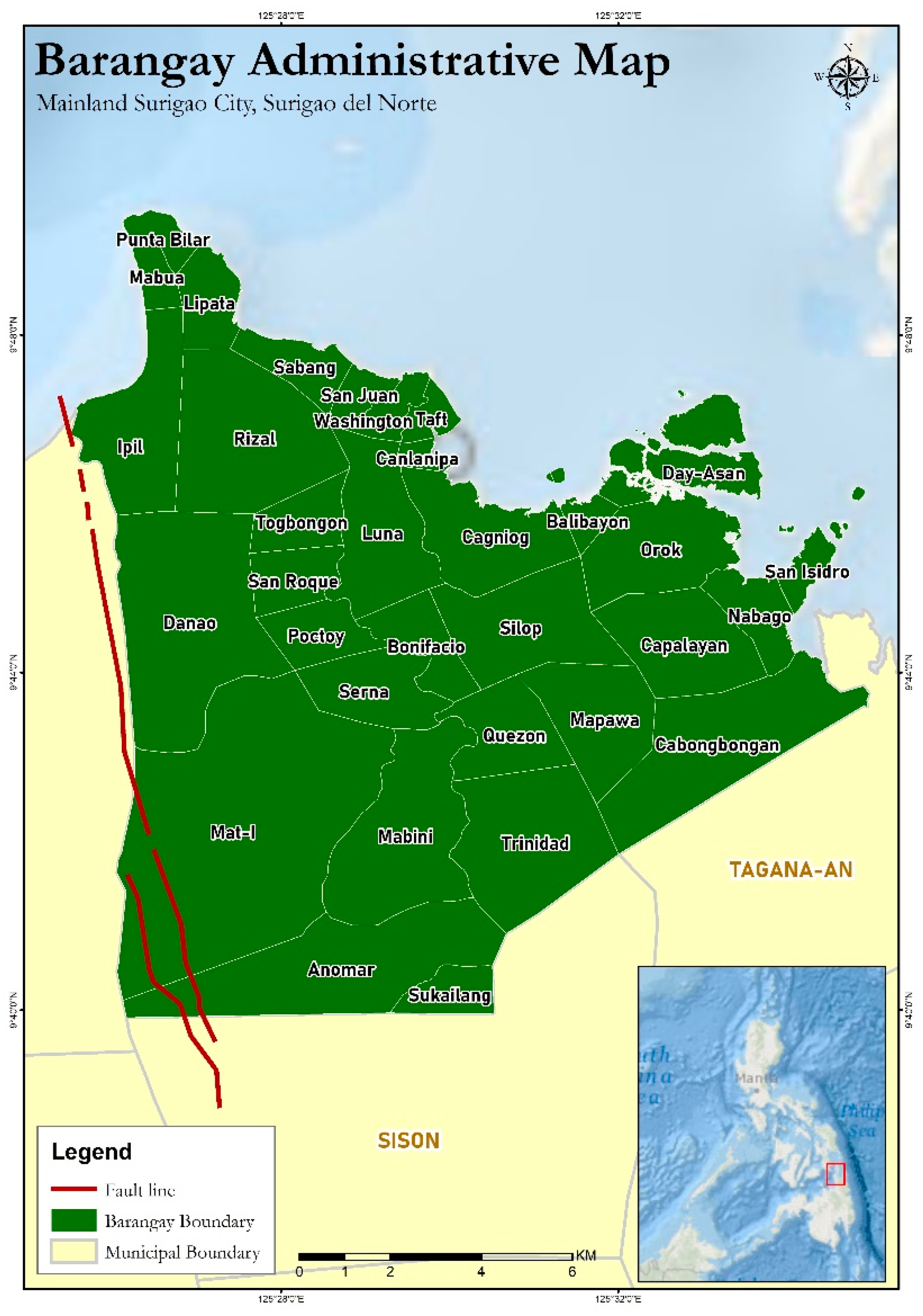
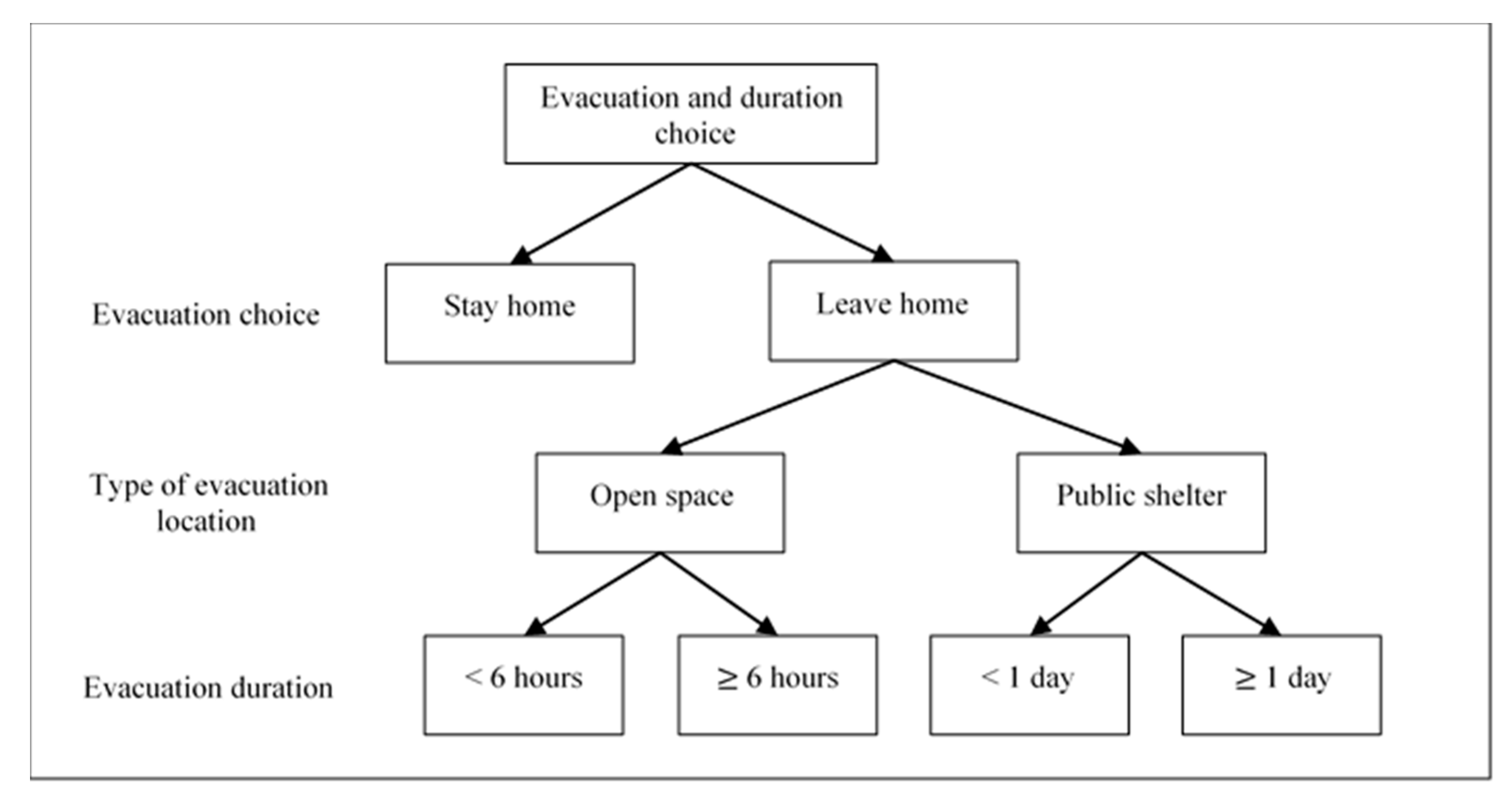

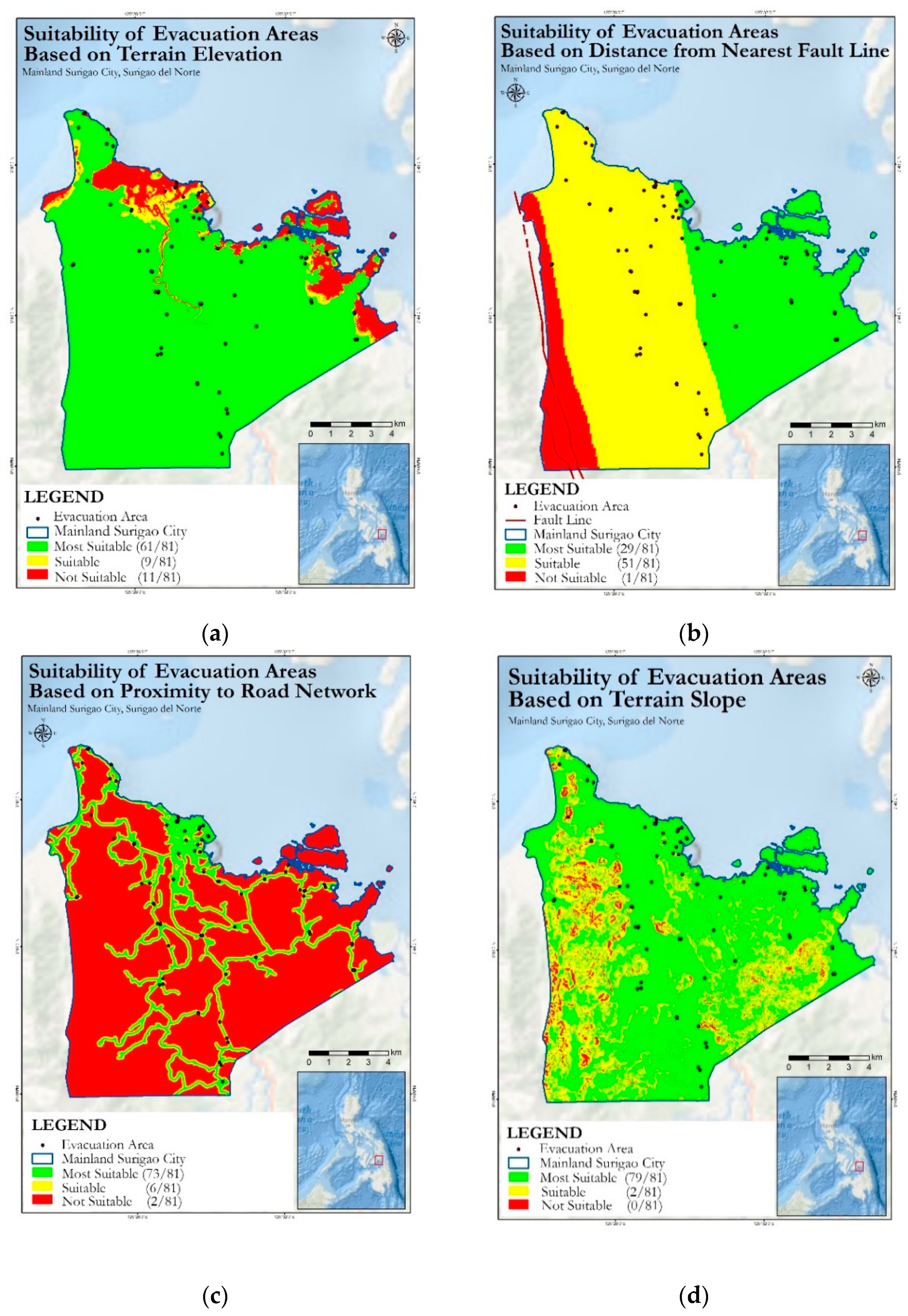
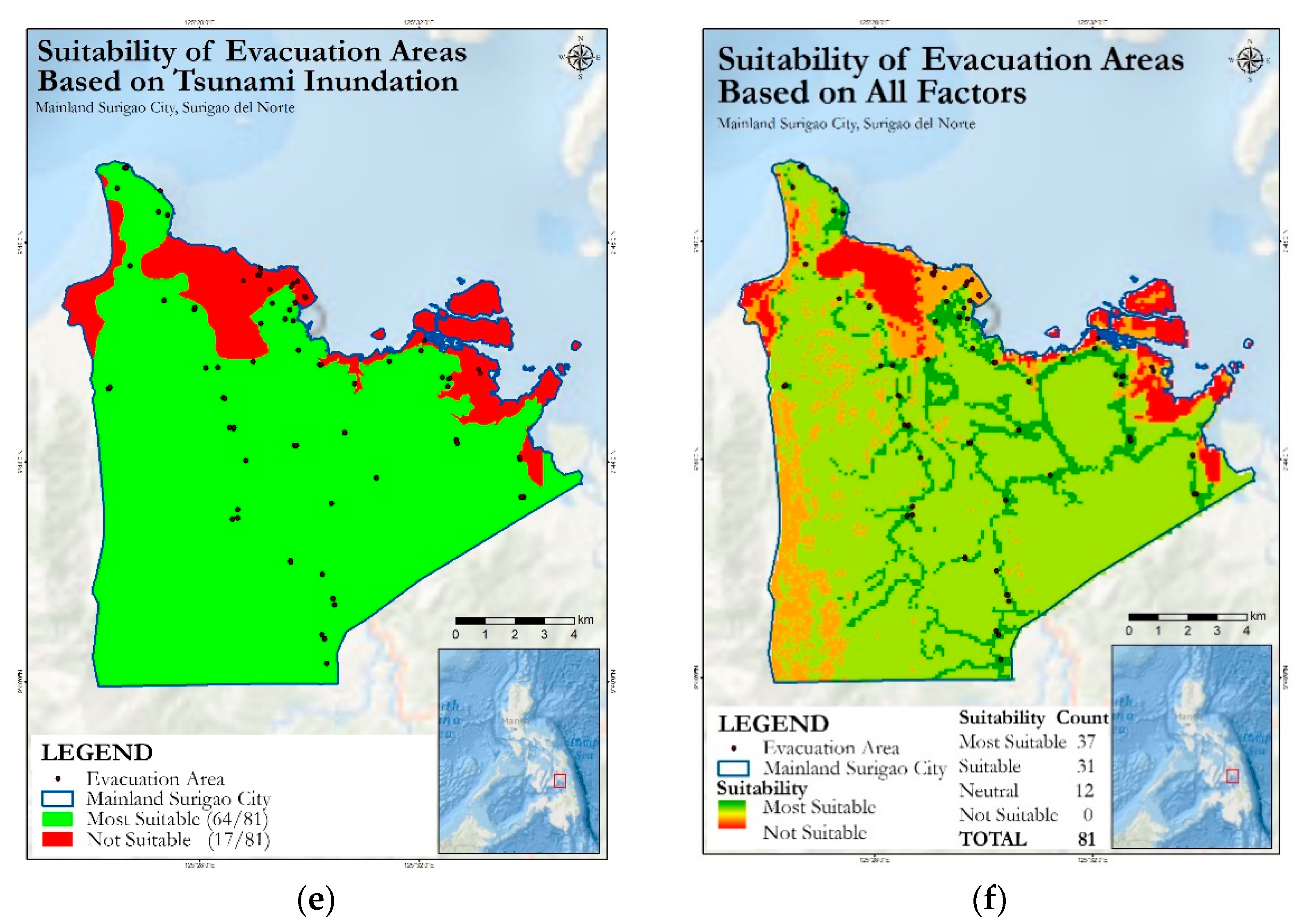
| Cluster | Barangays | Households in 2015 | TARGET | ACTUAL | |||
|---|---|---|---|---|---|---|---|
| Units | % | Samples | % | Samples | % | ||
| Rural-Coastal | 6 | 1920 | 6 | 63 | 6 | 74 | 7 |
| Rural-Inland | 14 | 6440 | 20 | 213 | 20 | 226 | 21 |
| Suburban | 8 | 6666 | 21 | 220 | 21 | 210 | 19 |
| Urban | 5 | 17,285 | 53 | 571 | 53 | 569 | 53 |
| TOTAL | 33 | 32,311 | 100 | 1067 | 100 | 1079 | 100 |
| Evacuation Choice | ||
|---|---|---|
| Stay home (401 counts = 38.01%) | ||
| Leave home (654 counts = 61.99%) | Open space (547 counts = 51.85%) | <6 h (387 counts = 36.68%) |
| ≥6 h (160 counts = 15.17%) | ||
| Public shelter (107 counts = 10.14%) | <one day (70 counts = 6.64%) | |
| ≥one day (37 counts = 3.51%) |
| Evacuation Choice | |
|---|---|
| Stay home (401 counts = 38.01%) | |
| Leave home (654 counts = 61.99%) | Walk (564 counts = 53.46%) |
| two- and three-wheeler (65 counts = 6.16%) | |
| Other modes (25 counts = 2.37%) |
| Variables | Categories | Counts | Percentage |
|---|---|---|---|
| Earthquake-related damage | |||
| Warning method | No warning | 790 | 74.88% |
| Radio/TV/Internet | 99 | 9.38% | |
| Megaphone/word-of-mouth | 166 | 15.73% | |
| House damage level | No | 496 | 47.01% |
| Moderate | 482 | 45.69% | |
| Severe/Complete | 77 | 7.30% | |
| Electricity cutoff | No | 353 | 33.46% |
| Yes | 702 | 66.54% | |
| Water cutoff | No | 674 | 63.89% |
| Yes | 381 | 36.11% | |
| Dwelling utilities and assets | |||
| Homeownership | Rented/live with relatives | 109 | 10.33% |
| Owned | 946 | 89.67% | |
| House building material | Timber | 276 | 26.16% |
| Concrete | 699 | 66.26% | |
| Other materials | 80 | 7.58% | |
| No. of floors | Ground floor | 883 | 83.70% |
| ≥1 floors | 172 | 16.30% | |
| Safe water | No | 48 | 4.55% |
| Yes | 1007 | 95.45% | |
| Electricity access | No | 30 | 2.84% |
| Yes | 1025 | 97.16% | |
| Toilet | No | 24 | 2.27% |
| Yes | 1031 | 97.73% | |
| Genset | No | 1018 | 96.49% |
| Yes | 37 | 3.51% | |
| No. of household motorcycles | 0 | 621 | 58.86% |
| 1 | 400 | 37.91% | |
| At least 2 | 34 | 3.22% | |
| No. of household cars | 0 | 1006 | 95.36% |
| At least 1 | 49 | 4.64% | |
| No. of household multicabs | 0 | 1032 | 97.82% |
| 1 | 23 | 2.18% | |
| No. of household trucks | 0 | 1052 | 99.72% |
| 1 | 3 | 0.28% | |
| No. of other household vehicles | 0 | 976 | 92.51% |
| At least 1 | 79 | 7.48% |
| Variables | Categories | Counts | Percentage |
|---|---|---|---|
| Gender | Male | 403 | 38.20% |
| Female | 652 | 61.80% | |
| Marital status | Single/window(er)/divorced | 274 | 35.45% |
| Married | 681 | 64.55% | |
| Age | 18–29 years | 272 | 25.78% |
| 30–39 years | 214 | 20.28% | |
| 40–49 years | 213 | 20.19% | |
| 50–59 years | 175 | 16.59% | |
| ≥ 60 years | 181 | 17.16% | |
| Educational level | Elementary and lower | 210 | 19.91% |
| High school and lower | 414 | 39.24% | |
| Higher than high school | 431 | 40.85% | |
| Occupation | Retired/Unemployed/student | 391 | 37.06% |
| Employee | 326 | 30.90% | |
| Self-employed | 338 | 32.04% | |
| Household head | No | 587 | 55.64% |
| Yes | 468 | 44.36% | |
| Household size | One person | 22 | 2.09% |
| Two people | 66 | 6.26% | |
| Three people | 165 | 15.64% | |
| Four people | 250 | 23.70% | |
| Five people | 214 | 20.28% | |
| Six people | 120 | 11.37% | |
| Seven people | 101 | 9.57% | |
| Eight people | 67 | 6.35% | |
| Nine people | 17 | 1.61% | |
| At least ten people | 33 | 3.13% | |
| No. of children aged ≤ 5 years | No child | 689 | 65.31% |
| One child | 229 | 21.71% | |
| Two children | 102 | 9.67% | |
| Three children | 27 | 2.56% | |
| At least four children | 8 | 0.75% | |
| No. of elderly people aged ≥ 65 years | No elderly person | 856 | 81.14% |
| One elderly person | 135 | 12.80% | |
| At least two elderly people | 64 | 6.06% | |
| No. of PWDs | No person with disabilities | 1009 | 95.64% |
| At least one person with disabilities | 46 | 4.36% | |
| No. of pets | No pet | 490 | 46.45% |
| One pet | 267 | 25.31% | |
| Two pets | 117 | 11.09% | |
| Three pets | 63 | 5.97% | |
| Four pets | 27 | 2.56% | |
| Five pets | 91 | 8.63% | |
| Residential period | <10 years | 133 | 12.61% |
| 10–19 years | 163 | 15.45% | |
| 20–29 years | 267 | 25.31% | |
| 30–39 years | 163 | 15.45% | |
| 40–49 years | 147 | 13.93% | |
| ≥ 50 years | 182 | 17.25% | |
| Individual income (PhP/month) | <5000 | 630 | 59.72% |
| 5000–9999 | 201 | 19.05% | |
| 10,000–14,999 | 117 | 11.09% | |
| 15,000–19,999 | 43 | 4.08% | |
| 20,000–24,999 | 26 | 2.46% | |
| 25,000–29,999 | 15 | 1.42% | |
| 30,000–34,999 | 10 | 0.95% | |
| ≥35,000 | 13 | 1.22% | |
| Household income (PhP/month) | <5000 | 232 | 21.99% |
| 5000–9999 | 250 | 23.70% | |
| 10,000–14,999 | 196 | 18.58% | |
| 15,000–19,999 | 147 | 13.93% | |
| 20,000–24,999 | 64 | 6.07% | |
| 25,000–29,999 | 48 | 4.55% | |
| 30,000–34,999 | 29 | 2.75% | |
| 35,000–39,999 | 12 | 1.14% | |
| 40,000–44,999 | 26 | 2.46% | |
| 45,000–49,999 | 8 | 0.76% | |
| 50,000–54,999 | 20 | 1.90% | |
| ≥55,000 | 23 | 2.18% |
| Stay Home | Open Space (<6 h) | Open Space (≥6 h) | Public Shelter (<one day) | Public Shelter (≥one day) | |
|---|---|---|---|---|---|
| Actual | 38.01% | 36.68% | 15.17% | 6.64% | 3.51% |
| Estimateed | 38.01% | 36.59% | 15.17% | 6.73% | 3.51% |
| Variable | Category | Evacuation Choice | Evacuation Location | Open Space | Public Shelter |
|---|---|---|---|---|---|
| Leave Home | Public Shelter | ≥6 h | ≥One Day | ||
| Intercept | −4.708 (0.84) *** | - | −3.09 (0.36) *** | −4.452 (0.72) *** | |
| Earthquake-related damage variables | |||||
| Warning method (No warning = ref.) | Telecommunication | 3.326 (1.16) ** | 0.869 (0.36) * | 0.827 (0.27) ** | - |
| Megaphone/ word-of-mouth | - | 0.775 (0.28) ** | 0.637 (0.24) ** | - | |
| Home damage level (No damage = ref.) | Moderate | - | 1.218 (0.32) *** | 1.817 (0.33) *** | - |
| Severe/ complete | 2.351 (1.09) * | - | 2.229 (0.42) *** | 3.391 (0.48) *** | |
| Electricity cutoff (No = ref.) | Yes | 3.982 (0.3) *** | - | - | - |
| Water cutoff (No = ref.) | Yes | 1.96 (0.34) *** | −1.906 (0.29) *** | 0.559 (0.22) ** | - |
| Dwelling utilities and assets | |||||
| Homeownership (No = ref.) | Yes | - | - | - | - |
| Home-building material (Other = ref.) | Timber | - | - | - | 0.73 (0.4). |
| Concrete | - | - | - | - | |
| No. of floors (At least one floor = ref.) | Ground floor | - | - | - | - |
| Safe water access (No = ref.) | Yes | 2.051 (0.55) *** | −1.322 (0.53) * | - | - |
| Electricity access at home (No = ref.) | Yes | 1.46 (0.77). | - | - | - |
| Toilet availability at home (No = ref.) | Yes | −1.885 (0.83) * | 1.014 (0.59). | - | - |
| Genset availability at home (No = ref.) | Yes | - | - | - | - |
| No. of household motorcycles (Continuous) | Unis | - | - | - | - |
| No. of household cars (Continuous) | Units | - | - | - | - |
| No. of household multicabs (Continuous) | Units | - | - | - | - |
| No. of household trucks (Continuous) | Units | - | - | - | - |
| No. of other vehicles in the household (Continuous) | Units | −0.759 (0.37) * | - | - | - |
| Sociodemographic characteristics | |||||
| Gender (Female = ref.) | Male | - | - | - | - |
| Marital status (Others = ref.) | Married | - | - | - | - |
| Age (At least 60 years = ref.) | 18–29 years | - | −1.398 (0.54) ** | - | 2.024 (0.68) ** |
| 30–39 years | - | - | - | - | |
| 40–49 years | - | - | - | - | |
| 50–59 years | - | - | - | - | |
| Educational level (Elementary and lower = ref.) | Highschool | - | - | - | - |
| Higher than high school | - | - | - | - | |
| Occupation type (Others = ref.) | Employee | - | - | - | - |
| Self-employed | - | −0.682 (0.33) * | - | 1.19 (0.5) * | |
| Household head (No = ref.) | Yes | 0.44 (0.25). | - | - | - |
| Household size (Continuous) | People | - | −0.342 (0.08) *** | - | 0.385 (0.11) *** |
| No. of children aged ≤ 5 years (Continuous) | Children | −0.293 (0.14) * | - | - | - |
| No. of elderly people (Continuous) | At least 65 years | - | - | - | - |
| No. of PWDs (Continuous) | People | - | - | 0.886 (0.43) * | - |
| No. of pets (Continuous) | Pets | - | - | - | - |
| Residential period (At least 50 years = ref.) | <10 years | - | - | - | - |
| 10–19 years | - | - | - | - | |
| 20–29 years | - | - | - | - | |
| 30–39 years | - | - | - | - | |
| 40–49 years | - | - | - | - | |
| Individual income (Continuous) | 103 PhP per month | - | - | - | - |
| Household income (Continuous) | 103 PhP per month | - | - | - | 0.031 (0.02) * |
| Log-Likelihood: −810.3219 | |||||
| Akaike Information Criterion (AIC): 1688.644 | |||||
| McFadden R2 = 0.009 | |||||
| “Stay home” is used as the reference for the top model. | |||||
| “Open space” is used as the reference for the middle model. | |||||
| “<6 h” is used as the reference for the bottom model of opens space sub-nest. | |||||
| “<one day” is used as the reference for the bootle model of public shelter sub-nest. | |||||
| ref.: reference | |||||
| “-“ signifies no parameter estimate or zero. | |||||
| Significance codes: 0 ‘***’ 0.001 ‘**’ 0.01 ‘*’ 0.05 ‘.’ 0.1 | |||||
| Stay Home | Leave Home | |||
|---|---|---|---|---|
| Walking | Two- and Three-Wheeler | Other Modes | ||
| Actual | 38.01% | 53.46% | 6.16% | 2.37% |
| Estimateed | 38.01% | 53.46% | 5.79% | 2.74% |
| Variable | Category | Evacuation Choice | Travel Mode Choice | |
|---|---|---|---|---|
| Leave Home | Walk | Two- and Three-Wheeler | ||
| Intercept | −6.982 (0.68) *** | 3.228 (0.25) *** | - | |
| Earthquake-related damage variables | ||||
| Warning method (No warning = ref.) | Telecommunication | 3.887 (1.09) *** | - | - |
| Megaphone/word-of-mouth | 2.093 (0.42) *** | −0.897 (0.25) *** | - | |
| Home damage level (No damage = ref.) | Moderate | 0.924 (0.29) ** | - | - |
| Severe/complete | 3.864 (1.06) *** | −0.684 (0.32) * | - | |
| Electricity cutoff (No = ref.) | Yes | 3.576 (0.34) *** | - | - |
| Water cutoff (No = ref.) | Yes | 1.975 (0.35) *** | - | 0.884 (0.23) *** |
| Dwelling utilities and assets | ||||
| Homeownership (No = ref.) | Yes | - | - | - |
| Home-building material (Other = ref.) | Timber | - | - | - |
| Concrete | - | - | - | |
| No. of floors (At least one floor = ref.) | Ground floor | −1.087 (0.39) ** | - | - |
| Safe water access (No = ref.) | Yes | 1.575 (0.49) ** | - | - |
| Electricity access at home (No = ref.) | Yes | - | - | - |
| Toilet availability at home (No = ref.) | Yes | - | - | - |
| Genset availability at home (No = ref.) | Yes | - | - | - |
| No. of household motorcycles (Continuous) | Unis | −0.427 (0.22). | - | - |
| No. of household cars (Continuous) | Units | - | - | - |
| No. of household multicabs (Continuous) | Units | - | - | - |
| No. of household trucks (Continuous) | Units | - | - | - |
| No. of other vehicles in the household (Continuous) | Units | −0.901 (0.42) * | - | - |
| Sociodemographic characteristics | ||||
| Gender (Female = ref.) | Male | - | - | - |
| Marital status (Others = ref.) | Married | - | −0.598 (0.22) ** | - |
| Age (At least 60 years = ref.) | 18–29 years | - | - | - |
| 30–39 years | 0.81 (0.36) * | - | - | |
| 40–49 years | - | 0.521 (0.31). | 0.785 (0.4). | |
| 50–59 years | 0.79 (0.37) * | - | - | |
| Educational level (Elementary and lower = ref.) | Highschool | −0.53 (0.26) * | - | - |
| Higher than highschool | - | - | - | |
| Occupation type (Others = ref.) | Employee | - | 0.476 (0.2) * | - |
| Self-employed | - | - | - | |
| Household head (No = ref.) | Yes | - | 0.548 (0.19) ** | - |
| Household size (Continuous) | People | - | - | - |
| No. of children aged below 5 years (Continuous) | Children | - | - | - |
| No. of elderly people (Continuous) | Aged at least 65 years | - | - | - |
| No. of PWDs (Continuous) | People | −6.719 (3.1) * | 6.839 (3.15) * | 7.037 (3.19) * |
| No. of pets (Continuous) | Pets | - | - | - |
| Residential period (At least 50 years = ref.) | <10 years | - | - | - |
| 10–19 years | - | - | - | |
| 20–29 years | - | - | - | |
| 30–39 years | - | - | - | |
| 40–49 years | - | - | - | |
| Individual income (Continuous) | 103 PhP per month | - | - | - |
| Household income (Continuous) | 103 PhP per month | - | - | - |
| Log-Likelihood: −527.5837 | ||||
| Akaike Information Criterion (AIC): 1107.167 | ||||
| McFadden R2 = 0.481 | ||||
| “Stay home” is used as the reference for the upper model. | ||||
| “Other modes” is used as the reference for the lower model. | ||||
| ref.: reference | ||||
| “-“ signifies no parameter estimate or zero. | ||||
| Significance codes: ‘***’ 0.001; ‘**’ 0.01; ‘*’ 0.05; ‘.’ 0.1 | ||||
| Factors (Criteria) | Sub-Criteria | Alternatives | Score | Weight (Rank) |
|---|---|---|---|---|
| Tsunami inundation | 1–4 m | Unsuitable | 1 | 35.0% (1) |
| <1 m | Most suitable | 5 | ||
| Terrain elevation | <1.5 m | Suitable | 3 | 19.3% (2) |
| >1.5 m | Most suitable | 5 | ||
| Proximity to the road network | >500 m | Unsuitable | 1 | 16.6% (3) |
| 250–500 m | Suitable | 3 | ||
| <250 m | Most suitable | 5 | ||
| Distance from the nearest fault line | <1000 m | Unsuitable | 1 | 16.1% (4) |
| 1000–7500 m | Suitable | 3 | ||
| >7500 m | Most suitable | 5 | ||
| Terrain slope | >30° | Unsuitable | 1 | 13.1% (5) |
| 15–30° | Suitable | 3 | ||
| <30° | Most suitable | 5 | ||
| TOTAL | 100% |
Publisher’s Note: MDPI stays neutral with regard to jurisdictional claims in published maps and institutional affiliations. |
© 2021 by the authors. Licensee MDPI, Basel, Switzerland. This article is an open access article distributed under the terms and conditions of the Creative Commons Attribution (CC BY) license (https://creativecommons.org/licenses/by/4.0/).
Share and Cite
Calumba, S.R.; Rith, M.; Fillone, A.M. Earthquake Evacuation Choice and Management in a Developing Archipelagic Country—A Case Study of Surigao City, Philippines. Sustainability 2021, 13, 5783. https://doi.org/10.3390/su13115783
Calumba SR, Rith M, Fillone AM. Earthquake Evacuation Choice and Management in a Developing Archipelagic Country—A Case Study of Surigao City, Philippines. Sustainability. 2021; 13(11):5783. https://doi.org/10.3390/su13115783
Chicago/Turabian StyleCalumba, Sherwin Roy, Monorom Rith, and Alexis M. Fillone. 2021. "Earthquake Evacuation Choice and Management in a Developing Archipelagic Country—A Case Study of Surigao City, Philippines" Sustainability 13, no. 11: 5783. https://doi.org/10.3390/su13115783
APA StyleCalumba, S. R., Rith, M., & Fillone, A. M. (2021). Earthquake Evacuation Choice and Management in a Developing Archipelagic Country—A Case Study of Surigao City, Philippines. Sustainability, 13(11), 5783. https://doi.org/10.3390/su13115783






